Sapphire Atlantis RADEON 9800 PRO 256MB Ultimate Edition
|
CONTENTS
- Video card's
features
- Testbed configuration,
test tools, 2D quality
- Test
results: Quake3 ARENA (speed and
quality)
- Test
results: Serious Sam: The Second
Encounter
- Test
results: Return to Castle Wolfenstein
- Test
results: Code Creatures DEMO (speed
with Anti-Detect)
- Test
results: Unreal Tournament 2003
(speed
with Anti-Detect and quality)
- Test
results: Unreal II: The Awakening (speed with Anti-Detect
and quality)
- Test
results: RightMark 3D (speed with Anti-Detect)
- Conclusion
A little kangaroo Wallaby came to Big Kangaroo and asked
him: Grandpa, why do they call us kangaroos? And what is Ultimate? Big Kangaroo
opened his bag, fished out a press release and started his story...
...Once upon a time, when Famous Chinese wasn't even born yet who then became
the best friend and partner of all PCs, the flow of sapphires from India
ran dry. There were still heaps of pearls, bars of gold and silver, sapphire
became a deficient product. The Earth refused to give more stones. They provoked
its wrath. Another famous Chinese (Number Two) was clairvoyant and he said
that they could save sapphires far-far away in Australia. To get there one
must go south east for a long time, cope with the ocean, pass numerous islands...
Thus the Indian kangaroos learned to jump for long distances. As you understand,
my dear Wallaby, kangaroos reached Australia. There they found what the Chinese
number Two told them. That was the sacred mountain. That was very long way
though deserts and steppes, red ground entirely the travelers. They carried
there the last sapphire in order to put it into the empty eye-socket of some
monster that petrified in that mountain. On their way aborigines followed
the kangaroos enchanted with such unusual animals. By the way, when the Europeans
pointed at a kangaroo and asked the aborigines what animals they were, one
of them said he didn't know. The Europeans thought that that was how those
animals were called. Since those times "Don't Know's" live happily in Australia.
Yes, my Wallaby, that Kangaroo did everything what the Chinese
Number Two ordered him. The Mountain rebelled not wanting to release the
revived monster with a shining eye but then it calmed down, and the monster
left for ocean. Afterwards in that cave people found a little baby. This
is what the Chinese Number Two ordered to bring back.
Later on that boy became a famous Chinese, a friend and partner of all PCs.
Soon he became related with the Chinese Number Two! The latter then realized
that although it's possible to do only with philosophy in one's life, that
old ugly magician started grasping many by throat and shining with his golden
coins... Yes, I mean business. Both Chinese men soon parted... The Number
Two left for Canada where he started his own business and named his firm ATI...
But nonetheless both remain excellent friends even now, and their business
is flourishing.
As to the sapphires, the Chinese Number One established a branch company
and named it Sapphire, and ordered everyone to wear sapphires on their navels:).
...Grandpa, but what about the sapphires in India and what about Ultimate?
- asked Wallaby... My Dear, it's enough that two great Chinese men found each
other, raised the family of kangaroos up to prophets and keep on fighting
against the Third Chinese from the United States... That's life, that's rasterization
in many pipelines with numerous texture units... As to sapphires... Hindu
people found a lot of substitutes for them in their trading business... As
to Ultimate, this is a special family, a special league of fans of Sapphire
who noiselessly conquer all fans of 3D.
That was just an introduction, and now comes the tale itself.
The summer has finally crossed the middle, and it's high time to
get prepared for winter, save money for warm clothes and... think about powerful
video cards deprived of fans, and therefore, noise. Noise seems to be the
worst problem of such cards. Users are ready to bear low-level trilinear filtering
and even anisotropy with artifacts in corners. The load on ears has become
unbearable. 350W power supply units have become an ordinary thing! And fans
are meant to take all that heat out of the PC cases! But the frictional force
is everywhere. Rotating parts touch each other and make noise. Well, the
times of the Riva128 have dropped into oblivion forever!
The latest powerful 3D accelerators and cooling systems remain an urgent
issue. The NVIDIA's example of the FlowFX showed us the negative experience.
Today I hope we will see a successful solution (according to the developers
of fanless equipment). But before we turn directly to our hero, have a look
at the reviews of the ATI R300/350.
Theoretical materials and reviews of video cards which concern
functional properties of the GPU ATI RADEON 9500/9700/9800
- Analysis of RADEON
9700 architecture and Microsoft DirectX 9.0
- ATI RADEON 9700 Pro
128MB Review
- Gigabyte MAYA II R9700Pro
128MB - performance estimated on the new Pentium 4 2.53 GHz
based platform, comparison with the NVIDIA's 40.41 driver
- Hercules 3D Prophet
9700 Pro 128MB - new CATALYST 2.3 driver estimated in 3DMark2001
SE, and Unreal Tournament 2003 DEMO final release
- PowerColor Evil Commando2
RADEON 9700 Pro 128MB - performance of the new CATALYST 2.3
driver estimated in game tests, 3D quality issues
- Hercules
3D Prophet 9700 Pro on ATI RADEON 9700 Pro: extreme overclocking
- ATI
RADEON 9500, 9700 and Gigabyte MAYA II RADEON 9500
- Sapphire Atlantis
RADEON 9500 128MB and videocards tests in DOOM III v.0.02
- ATI
RADEON 9500 PRO 128MB
- Gigabyte MAYA
II RADEON 9500 PRO and Hercules 3D Prophet 9500 PRO - detailed
analysis of anisotropic filtering of RADEON 9700
- Sapphire Technology
RADEON 7500, 8500, 9000/Pro, 9700 Pro, anisotropic filtering
of RADEON 9700
- HIS Excalibur RADEON
9700 PRO - Tests in DirectX 9.0 RC0
- ATI RADEON 9500
64MB, 9500 128MB, 9500 PRO, 9700 and 9700 PRO in DirectX 9.0: Part 1 - Game
tests in 3DMark2001, and Soft9700!
- ATI RADEON 9500
64MB, 9500 128MB, 9500 PRO, 9700 and 9700 PRO in DirectX 9.0: Part 2 - Tests
in DirectX 9.0 - synthetic tests from RightMark 3D
- Sapphire
Atlantis RADEON 9700 and RADEON 9700 PRO Ultimate Edition
- YUAN
SmartVGA RADEON 9000 64MB and RADEON 9700 PRO
- Connect3D video
cards on the ATI's chips
- ATI
RADEON 9800 PRO 128MB
- ATI RADEON
9600 PRO 128MB: Part 1 - game tests and performance
- Hercules 3D
Prophet 9800 PRO 128MB and Hercules 3D Prophet 7500 128MB, and
scandal around the 3DMark03
- Hercules
3D Prophet 9800 PRO 128MB and Hercules 3D Prophet 7500 128MB (single
page)
- Sapphire
Technologies ATI RADEON 9200/9600/9600PRO/9800PRO video cards
- Connect3D,
Gigabyte and CP.Technology ATI RADEON 9800 PRO video cards
- Sapphire
Atlantis RADEON 9600 256MB, Sapphire Atlantis RADEON 9600 PRO Ultimate
Edition 128MB, Gigabyte RADEON 9600 PRO 128MB, Hercules 3D Prophet
9600 PRO 128MB
- Manli
RADEON 9800 PRO 256MB on the ATI RADEON 9800 PRO
So, a company decided to equip its baby with a special cooler that
had no fans. The name of that company is Sapphire Technology, it's situated
in Hong Kong, and it is a branch company of PC Partner - a powerful concern
that produces a wide range of components including video cards based on ATI
Technologies' GPUs.
This model is based on the 0.15 micron technology, has a huge die and heats
a lot. But not that much compared to NVIDIA's products based on the 0.13
micron technology. The tests show that a simple active cooler is enough for
the the RADEON 9800 PRO. It doesn't even need heavy copper sinks. But there
is one strange thing: 450MHz on 0.13 microns can't outdo 380 MHz on 0.15
microns. It seems that ATI and nVIDIA have traded their places (at the time
of GeForce3/RADEON 8500 NVIDIA showed better performance for 1 MHz).
Now Sapphire decided to improve their High-End product and release
the same but with the cooler replaced with two big heatsinks (though this
is just an OEM product from Zalman).
Let's have a look at this wonder.
Card
| Sapphire Atlantis RADEON 9800 PRO 256MB Ultimate Edition
|

|

|
The card has AGP x8/x4/x2 interface, 256 MB DDR-II
SDRAM memory in 16 chips on both PCB sides.
|
| Sapphire Atlantis RADEON 9800 PRO 256MB Ultimate Edition
|
| Samsung memory chips of 2.2ns access time which corresponds to
454 (908) MHz. Memory works at 350 (700) MHz, GPU at 380 MHz. 256bit
memory interface. |

|
| Comparison with the reference design, front view |
| Sapphire Atlantis RADEON 9800 PRO 256MB Ultimate Edition |
Reference card ATI RADEON 9800 PRO 256MB |

|

|
| Comparison with the reference design, back view |
| Sapphire Atlantis RADEON 9800 PRO 256MB Ultimate Edition |
Reference card ATI RADEON 9800 PRO 256MB |

|

|
|
This is a copy of the reference card with just another cooler. There
is even a cut on the memory sink below on the right of the cooler (that cut
was made for the reference cooler of the parallelogram shape).
Now comes the cooler.
| Sapphire Atlantis RADEON 9800 PRO 256MB Ultimate
Edition |
|
The cooler consists of two massive aluminum heatsinks with
a copper gold-plated pipe with low-boiling liquid between them. This pipe
carries heat from the front heatsink to the rear one. There is thermal grease
between the pipe and heatsinks where they touch each other.
The mounting system is very reliable and consists of screws
near the chip and buckles between the sinks over the card.
|

|

|

|

|
That's nice that the sinks are placed quite high, and it's guaranteed
that the north bridge coolers located close to the AGP slot won't be an obstacle
on the way of such card.
This is how the card looks in the mainboard.
And this is after 10 hours in 3D. The sink got red :-) (it's a joke).
You can see that if a PCI card has components on its backside it
can't be inserted into the first slot; besides, such card would prevent proper
ventilation.
The card ships in the retail package.
|
| Sapphire Atlantis RADEON 9800 PRO 256MB Ultimate Edition
|
|
The box is different from those dull packages that RADEON 9800 based
cards shipped in before. Now it has a window in the plastic through which
one can see the card itself.
But again I must emphasize that this is a High-End product! Why
wouldn't they think out something except cardboard? NVIDIA's partners look
more creative.
The box contains a user guide, a CD with software including Red
Line utility, Return
to Castle Wolfenstein, Soldier of Fortuna II games, DVI-to-d-Sub,
S-Video-to-RCA adapters.
|

|

|

|
|
Testbed and drivers
Testbed:
- Pentium 4 3200 MHz based computer:
- Intel Pentium 4 3200 MHz CPU;
- DFI LANParty Pro875 (i875P) mainboard;
- 1024 MB DDR SDRAM;
- Seagate Barracuda IV 40GB HDD;
- Windows XP SP1; DirectX 9.0a;
- ViewSonic P810 (21") and ViewSonic P817
(21") monitors.
- ATI drivers v6.368.
VSync off, S3TC off in applications.
Cards used for comparison:
- Reference card NVIDIA GeForce FX 5900 Ultra (450/425 (850)
MHz, 256 MB, driver 44.90).
Test results
Before we start examining 2D quality, I should say there are no complete
techniques for objective 2D quality estimation because:
- 2D quality much depends on certain samples for almost all modern
3D accelerators;
- Besides videocards, 2D quality depends on monitors and cables;
- Moreover, certain monitors might not work properly with certain
video cards.
With the ViewSonic P817 monitor and BNC Bargo cable the card showed
excellent quality at the following resolutions and clock speeds:
|
| Sapphire Atlantis RADEON 9800 PRO 256MB Ultimate Edition |
1600x1200x85Hz, 1280x1024x120Hz, 1024x768x160Hz |
|
In general, 2D quality is excellent (but of this sample and in these
conditions).
Test results: cards' performance
Conventional signs: ANISO 8xP - Anisotropic 8x Performance (earlier
it was called Balanced), ANISO 8xQ - Anisotropic 8x Quality, ANISO 16xQ -
Anisotropic 16x Quality.
Test applications:
- Return to Castle Wolfenstein (MultiPlayer) (id Software/Activision)
- OpenGL, multitexturing, ixbt0703-demo, test settings - maximum, S3TC
OFF, the configurations can be downloaded from here
- Serious Sam: The Second Encounter v.1.05 (Croteam/GodGames)
- OpenGL, multitexturing, ixbt0703 demo, test settings: quality, S3TC
OFF
- Quake3 Arena v.1.17 (id Software/Activision) - OpenGL, multitexturing,
ixbt0703
demo, test
settings - maximum: detailing level - High, texture detailing
level - #4, S3TC OFF, smoothness of curves is much
increased through variables r_subdivisions "1" and r_lodCurveError
"30000" (at default r_lodCurveError is 250 !), the configurations
can be downloaded from here
- Unreal Tournament 2003 v.2225 (Digital Extreme/Epic Games) -
Direct3D, Vertex Shaders, Hardware T&L, Dot3, cube texturing,
default quality
- Code Creatures Benchmark Pro (CodeCult) - the game that demonstrates
card's operation in DirectX 8.1, Shaders, HW T&L.
- Unreal II: The Awakening (Legend Ent./Epic Games) - Direct3D,
Vertex Shaders, Hardware T&L, Dot3, cube texturing, default quality
- RightMark 3D
v.0.4 (one of game scenes) - DirectX 8.1, Dot3, cube texturing,
shadow buffers, vertex and pixel shaders (1.1, 1.4).
If you want to get the demo benchmarks that we use let me know by
e-mail.
There are a lot of materials on the Net that the trilinear filtering
doesn't work properly in UT2003 in NVIDIA's cards (see http://www.beyond3d.com/, HardOCP etc.). From time to time we will
touch upon this issue.
Quake3 Arena
Well, they are almost equal. In comparison with the Quality level
the RADEON 9800 has a higher speed, but the quality of this function is
higher in case of NVIDIA. If we compare it with the Performance level, where
NVIDIA has its own downsides like inferior trilinear filtering and
anisotropy on far objects, RADEON 9800 will lose its leadership.
Now quality of these functions. First comes the pure trilinear filtering
(without anisotropy).
RADEON 9800
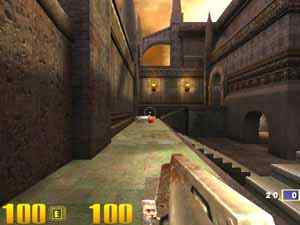 
The quality is OK. Now with the anisotropy 16x Quality:
RADEON 9800
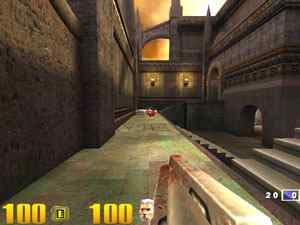 
Now the high-level trilinear filtering, all functions work entirely
in the OpenGL .
Serious Sam: The Second Encounter
The RADEON 9800 falls behind in the heavy modes, and comes ahead
in the light ones. If we compare the Quality/Quality anisotropic levels,
the Sapphire comes forward. But in general, they go on a par taking into
account high quality of the RADEON 9800 in the AA4x mode compared to the
GeForce FX 5900.
Return to Castle Wolfenstein (Multiplayer)
Here the RADEON 9800 takes the lead in most cases. But if we compare
the Performance (NVIDIA) to Quality (ATI) the GeForce FX 5900 goes ahead
due to its anisotropy optimization and simpler trilinear filtering.
Code Creatures
In the v44.90 of NVIDIA the cheats for this benchmark are removed.
Plus, normal anisotropy. The RADEON 9800 has a solid advantage! Here are
also results of the FX5900 with the Anti-Detect, that proves that the cheats
are absent. Unfortunately, the Anti-Detect works only in the Detonator up
to v44.65 inclusive; plus, it has problems with anisotropy, that is why we
can compare their performance with AD only without anisotropic filtering.
By the way, the developer of Anti-Detect Aleksei Nikolaichuk AKA Unwinder
is thinking why the NVIDIA driver doesn't turn on anisotropy in this test
when the Anti-Detect is on. Obviously, the latter works but the driver is
not aware that this particular benchmark is started. Why doesn't the Detonator
enable this function? The question is open.
Unreal Tournament 2003
There is an approximate parity again. With the optimizations disabled
the speed of the FX5900 sharply falls down, and the RADEON 9800 has
a great advantage. We have already discussed why NVIDIA uses optimizations
in UT2003 and doesn't Unreal II (the game on the same engine). The
examination with the Anti-Detect on the ATI drivers showed that no
cheats are used in any game tests (3DMark is not used anymore). That is exactly
why we compare the FX5900 with Anti-Detect with the RADEON 9800 without AD.
Now the quality issue. In the UT2003 we can enable trilinear filtering
and choose an anisotropy level. Let's turn on only the trilinear filtering
(High Quality of ATI and NVIDIA). The MIP levels are colored from
the console with the variable "FirstColoredMIP 1".
RADEON 9800
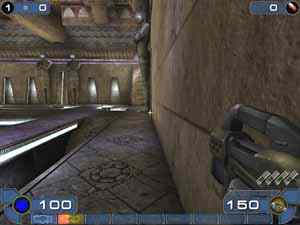 
FX 5900
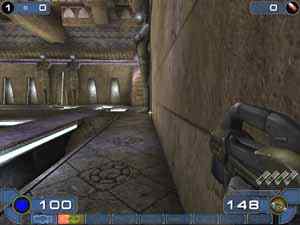 
FX 5900 with Anti-Detect
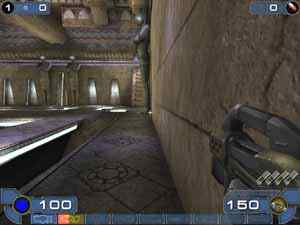 
One more sin of NVIDIA. Isn't it the gist of their optimizations?
Although the Quality preset is used, the trilinear filtering is not of the
high level. The Anti-Detect reveals the real situation. Judging by the speed
difference, the trilinear filtering alone can't cause such difference. But
in the game the difference between the simplified and normal trilinear filtering
isn't noticeable, the borders between the MIP levels do not catch the eye.
Now let's force anisotropy 16x and 8x at Quality and Performance
(in the game itself the game is disabled).
RADEON 9800 Quality
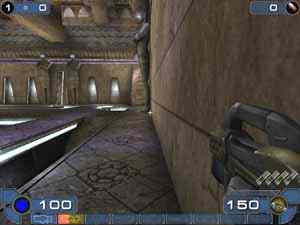 
RADEON 9800 Performance
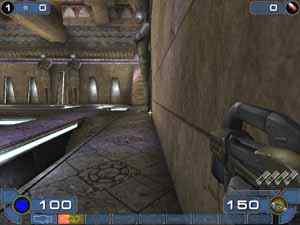 
FX 5900
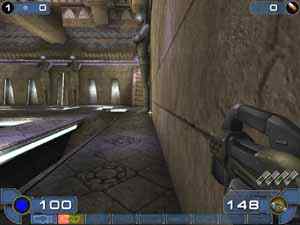 
FX 5900 with Anti-Detect
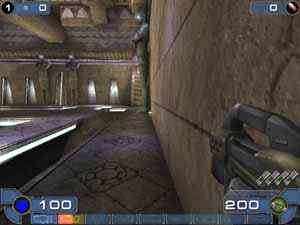 
One more surprise! As to NVIDIA, it was clear even in the previous
test that they use simpler trilinear filtering which was proved with the
Anti-Detect. And what about ATI? I've got a bad feeling... There is
no trilinear filtering at all! Then what?
Now let's enable in the game with ut2003.ini and disable in the
drivers.
Now the RADEON 9800 uses the normal trilinear filtering! It turns
out that the driver detects a game, asks it whether it knows about anisotropy,
and if the game says it doesn't "know how", the anisotropy forcing is successful.
And if the game "knows how", the driver "overcomes" settings in the game
and sets user's ones. Or it can give the control over this function to the
game, and until the game enables its optimization it doesn't work. Both variants
are logic, though the second one is strange because - why forcing then? But
there is the third variant that works indeed: the ATI driver detects a game,
asks for the anisotropy level enabled, and if the function is off, it sets
a lower level for the trilinear filtering. May be a cheats?
No. ATI engineer tells me, and forum of Beyond3D has the same information.
ATI doesn't detect the application, this is just how their control
panel AF works. In Quality mode only texture stage 0 has
Trilinear, all other stages have Bilinear - so with multitexturing you
are getting a Trilinear and Bilinear blend. This is occurring in all
cases with the app controlled AF, but you only "see" it in UT2003
because of the nature of the textures.
Any application that has AF controls, as UT2003 does, will receive
full Trilinear on all layers if the application requests it.
The FX 5900 doesn't show normal trilinear filtering without the
Anti-Detect either.
Now we leave the anisotropy enabled in the game and force it in
the drivers.
The NVIDIA driver didn't understand what's they want from it and disabled
the true trilinear filtering at all :-) ATI driver makes the bilinear.
In general, everyone is guilty including the game developers.
- ATI: the
normal anisotropy and the trilinear filtering work only when they are enabled
in the game itself; for this purpose you must change ut2003.ini, but not
every gamer can do it. ATI programmers must decide this question.
- NVIDIA: there are cheats as usual...
- Game developers: if you bring into game the anisotropy control,
why to hide it from users? Why not to make it available in the options panel!
The subject will be discussed further in the next test because it's
based on the same engine.
Unreal II: The Awakening
The speed of the RADEON 9800 is brilliant. NVIDIA has no
cheats for this game.
Now let's have a look at the quality level with the trilinear and
anisotropic filtering enabled together. At the Performance level the RADEON
9800 has no trilinear filtering at all and the FX 5900 has it very crippled.
Unfortunately, the MIP levels coloring in the Unreal II looks
very strange: starting from the second level everything is colored black.
However, it excellently shows the border between the MIP levels.
Now we force anisotropy in the Quality mode where the trilinear
filtering must be normal:
The trilinear filtering is well seen. Why does it look so complicated
in the UT2003 which has benchmarks and why don't we see such problems in
the Unreal II that doesn't offer standard tests? Well, business has its own
tricks.
RightMark 3D
The victory of the RADEON 9800 is obvious. However, some fans of
the FX 5900, especially those who have already bought the 5900 Ultra at very
high prices, will keep on asserting that these shaders are not needed in
the near future, and when the games become available, all these cards will
jump into the middle-end sector. The time will show whether they are right.
I understand them: they paid $500 for such a powerful device running at 450
MHz and then saw such a lousy card at 380 MHz which easily beats their monster...
Some need speed in the Quake3, some need it in future shader games...
|
Conclusion
Obviously, the RADEON 9800 PRO 256MB and the GeForce FX 5900
Ultra are the most powerful accelerators for today. But the examination of
some or other NVIDIA's manipulations in the tests might make the RADEON 9800
PRO a leader. The only thing that I don't understand is why to pay
so much for unnecessary 128 MB since they give a very small margin.
I understand that it was discussed a lot in the Beyond3D, and ATI cried that
the game developers hid the anisotropy too deeply... But still, it's very
unpleasant to see such problems with trilinear filtering and only in this
game.
As to the card itself, I must say that it noticeably heats up. When
tested outside the PC case, the sink reached 70-75 degrees C after a 10-hour
operation in 3D! Imagine how hot the insides would be! That is why if
your PC case doesn't have ventilation, you can easily damage the card and
some of the components inside the PC case!
In general, the Sapphire Atlantis RADEON 9800 PRO 256MB Ultimate
Edition can offer you:
- Very high speed in 3D graphics, it's almost a leader in 3D;
- Finished technological solution with DX9 support;
- No noise from the fan (however, you might need proper ventilation
in the PC case, i.e. it might need installation of fans);
- Pleasure from such an attractive appearance :-).
I hope the price will be adequate.
In our 3Digest
you can find full comparison characteristics for video cards of this and
other classes.
Write a comment below. No registration needed!
|
|
